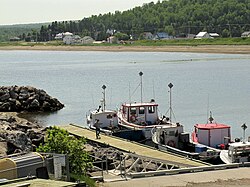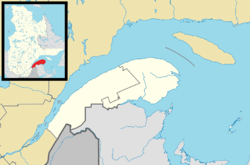Port-Daniel–Gascons
Port-Daniel–Gascons | |
|---|---|
 Harbour at Port-Daniel–Gascons | |
 Location within Le Rocher-Percé RCM | |
| Coordinates: 48°11′N 64°58′W / 48.183°N 64.967°W[1] | |
| Country | Canada |
| Province | Quebec |
| Region | Gaspésie–Îles-de-la-Madeleine |
| RCM | Le Rocher-Percé |
| Constituted | January 17, 2001 |
| Named for | Charles Daniel and Gascon people[1] |
| Government | |
| • Mayor | Henri Grenier |
| • Federal riding | Gaspésie—Îles-de-la-Madeleine |
| • Prov. riding | Bonaventure |
| Area | |
• Total | 334.78 km2 (129.26 sq mi) |
| • Land | 300.29 km2 (115.94 sq mi) |
| Population (2021)[3] | |
• Total | 2,271 |
| • Density | 7.6/km2 (20/sq mi) |
| • Pop (2016-21) | |
| • Dwellings | 1,227 |
| Time zone | UTC−5 (EST) |
| • Summer (DST) | UTC−4 (EDT) |
| Postal code(s) | |
| Area code(s) | 418 and 581 |
| Highways | |
| Website | munpdg |
Port-Daniel–Gascons (French pronunciation: [pɔʁ danjɛl ɡaskɔ̃]) is a municipality in the Gaspésie-Îles-de-la-Madeleine region of the province of Quebec in Canada.
The municipality includes the communities of Marcil, Clemville, Port-Daniel-Ouest, Port-Daniel-Est, Gascons-Ouest, and Gascons-Est. It is bordered to the south by Chaleur Bay, to the north by the interior of the Gaspésie, to the west by Shigawake, and to the east by Chandler (Newport District).
History
[edit]Port-Daniel
[edit]The area was originally inhabited by the Mi'kmaq people, who called the place Epsegeneg, meaning "place where people warm themselves".[1]
In 1534, Jacques Cartier visited the coast and named the bay (at the current townsite of Port-Daniel) Conche Saint-Martin. But Emmanuel Jumeau would record Port Daniel on his 1685 map, likely named after Dieppe merchant Charles Daniel, who made several voyages to New France as a ship captain. The name Port Daniel would also be used for the seignory that was established there, and granted to René Deneau in 1696.[1]
Early in the 19th century, further development came with the arrival of Scottish settlers. By 1825, there were 825 settlers, mostly of Irish, English, and Jersey origin. Americans followed before the middle of the century and set up a lobster cannery there in 1847.[1]
In 1845, the Township Municipality of Port-Daniel was created, abolished in 1847, and reestablished again in 1855. In 1882, it was divided into the Township Municipalities of Port-Daniel-Partie-Est (east part) and Port-Daniel-Partie-Ouest (west part). In 1990, these 2 township municipalities were joined again into the Municipality of Port-Daniel.[1]
Gascons
[edit]Gascons Cove (French: Anse aux Gascons) was named after a sailor from Gascony who shipwrecked there. In the middle of the 19th century, the place was settled by Gascons, Normans, Acadians, Basques, and Jersey people.[1]
In 1899, the Parish of Sainte-Germaine-de-l'Anse-aux-Gascons was founded, named after Germaine Cousin, a saint also of Gascon origin, and the cove. In 1902, the namesake parish municipality was established.[1]
Port-Daniel–Gascons
[edit]Port-Daniel–Gascons was formed on January 17, 2001, through the merger of the Municipality of Port-Daniel (founded in 1990) and the Parish Municipality of Sainte-Germaine-de-l'Anse-aux-Gascons (founded in 1902).[1]
In 2017, McInnis Cement, the largest cement plant in the province of Quebec, was inaugurated in the Municipality of Port-Daniel–Gascons. The cement plant was constructed between 2014 and 2017. It will bring in $2.1 million annually in tax revenue.
Demographics
[edit]Population
[edit]| 2021 | 2016 | 2011 | |
|---|---|---|---|
| Population | 2,271 (+2.8% from 2016) | 2,210 (-9.9% from 2011) | 2,453 (-5.1% from 2006) |
| Land area | 300.29 km2 (115.94 sq mi) | 301.60 km2 (116.45 sq mi) | 302.69 km2 (116.87 sq mi) |
| Population density | 7.6/km2 (20/sq mi) | 7.3/km2 (19/sq mi) | 8.1/km2 (21/sq mi) |
| Median age | 56.0 (M: 54.4, F: 57.6) | 54.7 (M: 54.1, F: 55.3) | 50.8 (M: 49.8, F: 52.1) |
| Private dwellings | 1,227 (total) 1,079 (occupied) | 1,140 (total) | 1,173 (total) |
| Median household income | $59,200 | $48,384 | $39,428 |
| Year | Pop. | ±% |
|---|---|---|
| 2001 | 2,685 | — |
| 2006 | 2,586 | −3.7% |
| 2011 | 2,453 | −5.1% |
| 2016 | 2,210 | −9.9% |
| 2021 | 2,271 | +2.8% |
| Source: Statistics Canada[9] | ||
Language
[edit]| Canada Census Mother Tongue - Port-Daniel–Gascons, Quebec[3][9] | ||||||||||||||||||
|---|---|---|---|---|---|---|---|---|---|---|---|---|---|---|---|---|---|---|
| Census | Total | French
|
English
|
French & English
|
Other
| |||||||||||||
| Year | Responses | Count | Trend | Pop % | Count | Trend | Pop % | Count | Trend | Pop % | Count | Trend | Pop % | |||||
2021
|
2,270
|
1,965 | 86.6% | 285 | 12.6% | 15 | 0.7% | 10 | 0.4% | |||||||||
2016
|
2,210
|
1,945 | 88.0% | 245 | 11.1% | 15 | 0.7% | 5 | 0.2% | |||||||||
2011
|
2,445
|
2,095 | 85.7% | 335 | 13.7% | 15 | 0.6% | 0 | 0.0% | |||||||||
2006
|
2,580
|
2,175 | n/a | 84.3% | 375 | n/a | 14.5% | 10 | n/a | 0.4% | 20 | n/a | 0.8% | |||||
Government
[edit]
The mayors of Port-Daniel–Gascons since 2001 are as follows:
- Maurice Anglehart (2001-2005)
- Henri Grenier (2005-2009)
- Maurice Anglehart (2009-2013)
- Henri Grenier (2013-present)
On October 1, 2021, Henri Grenier was re-elected without opposition for a fourth (third consecutive) term as mayor (2021-2025).
Infrastructure
[edit]
The main road in town is Quebec Route 132.
VIA Rail ceased service to Port-Daniel station due to track closures and local bridge conditions in 2013. The station is located close to the city hall.
Notable people
[edit]- Édouard Gagnon (1918 – 2007), a Canadian Roman Catholic Cardinal
- Hazel McCallion (1921 – 2023), former mayor of Mississauga, Ontario
See also
[edit]References
[edit]- ^ a b c d e f g h i "Banque de noms de lieux du Québec: Reference number 366565". toponymie.gouv.qc.ca (in French). Commission de toponymie du Québec.
- ^ a b "Répertoire des municipalités: Geographic code 02047". www.mamh.gouv.qc.ca (in French). Ministère des Affaires municipales et de l'Habitation. Retrieved 2024-09-11.
- ^ a b c "Port-Daniel–Gascons (Code 2402047) Census Profile". 2021 census. Government of Canada - Statistics Canada. Retrieved 2024-09-11.
- ^ "2021 Community Profiles". 2021 Canadian census. Statistics Canada. February 4, 2022. Retrieved 2022-04-27.
- ^ "2016 Community Profiles". 2016 Canadian census. Statistics Canada. August 12, 2021. Retrieved 2024-08-05.
- ^ "2011 Community Profiles". 2011 Canadian census. Statistics Canada. March 21, 2019. Retrieved 2014-01-30.
- ^ "2006 Community Profiles". 2006 Canadian census. Statistics Canada. August 20, 2019.
- ^ "2001 Community Profiles". 2001 Canadian census. Statistics Canada. July 18, 2021.
- ^ a b 2006, 2011, 2016, 2021 census

